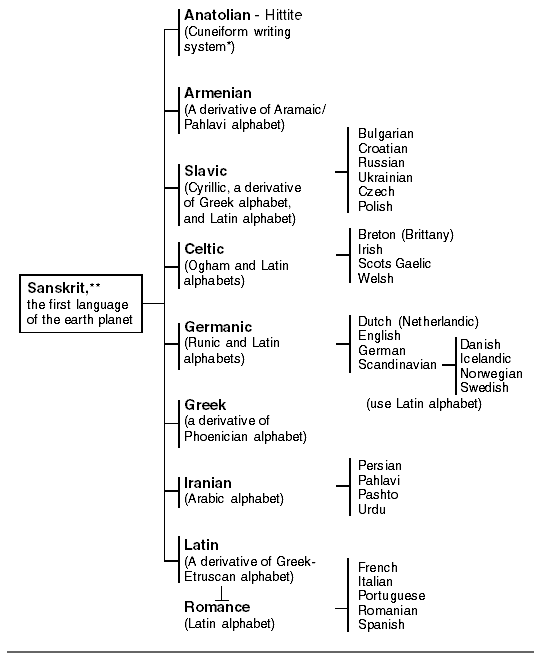(29) The eternal perfection
of the Sanskrit language which
is the mother language of the world.
Now we come back to the defects of the
statement of Sir William Jones of 1786 and subsequently its blind
acceptance by the writers of the whole world without checking its
credibility.
We have already explained in article
11 about the perfection of the alphabet, grammar, word formation,
morphology, the literary presentation, and have discussed about the eternal stability of the Sanskrit language whose
apbhransh words were adopted by all other languages of the world.
Anyone studying Sanskrit grammar understands these facts from the
beginning as they are the basic characteristics of the Sanskrit language,
whereas all the western and the Middle East writing systems developed from
the Phoenician and Aramaic alphabets which only had syllabic consonants
and no vowels, and that also in an incomplete form.
Major languages of the European family.
The most important language family of today.
(An image of the alphabet and vowel system and
certain apbhranshas of the Sanskrit language are found in every
language of the world because Sanskrit is the first language of the earth
planet. Its apbhranshas are seen more in the languages of the
European family because these countries had more frequent trade
connections with India, and thus, the people of these countries also had
social connections with India to some extent. Thatís why Pahlavi of Persia
had lots of Sanskrit apbhransh words in it.)

*
Next to the name of each language their alphabetic system is also
mentioned.
** Indian languages: Hindi, Bengali, Gujarati, Marathi and South
Indian languages are the descendants of Sanskrit language. Sindhi and
Punjabi are the derivatives of Hindi and Urdu languages.
Languages of the world.
As detailed in articles
13, 14 and
15, you can see that these languages never even had their
own alphabet. The Iranian language, Persian, borrowed its alphabet three
times from three different sources (cuneiform, to Aramaic, to Arabic)
within 1,300 years and in its advanced stage it has only three (a, i, u)
vowel marks which are used for both long and short sounds. They are
totally inadequate to give the correct pronunciation of the words. So,
unless you know the words, you cannot pronounce them correctly. The Greek
language started from incomplete consonants which was borrowed from
Northern (Phoenician) Semites, then added some vowels, improved the shape
of the letters, added more long and short vowels, and thus, improved the
language by constantly changing, altering, adding and modifying the word
morphology, their inflection and the syntax as well. It also improved its
vocabulary by borrowing the words from other languages, and thus, bringing
it to the level of its modern standard where still a number of grammatical
imperfections exist. Similar is the history of all the languages of the
world. Latin and English languages also went through a number of changes
before even their vocabulary was standardized from Germanic tribal
language, which adopted Latin alphabet and then modified it.
Sanskrit language.
How it became the origin of the languages of the
world.
Sanskrit language, as we see is all-perfect from the
very beginning when the western world didnít even have a proper alphabet.

The words of the Vedas like: vishanti, upasate are used in the same way in the
Gita and the Puranas because there has never been any change or
improvement in the formation of its words as it was the self-perfected
language, which is also an indication of its Divineness.
This situation itself is the authentication of this
fact that Sanskrit is the first and the mother language of the world; and
its unique and eternal perfection, which is unimagined and unmatched in
the world, is the positive verdict of its being a Divine (supernatural)
language.
